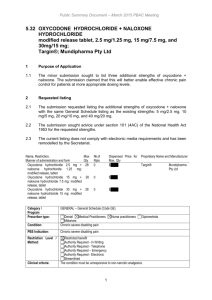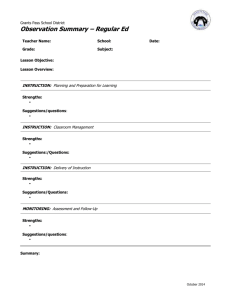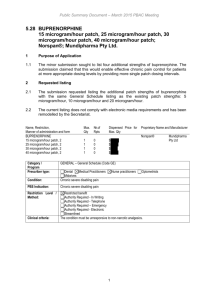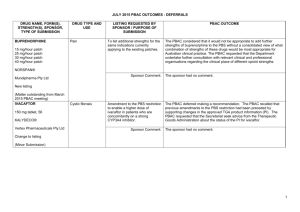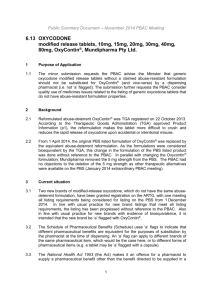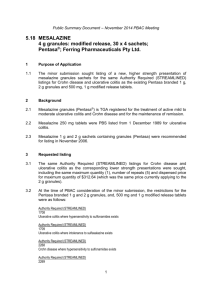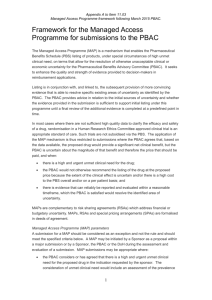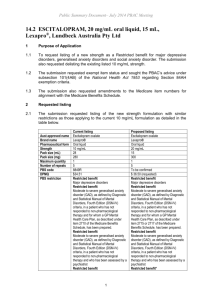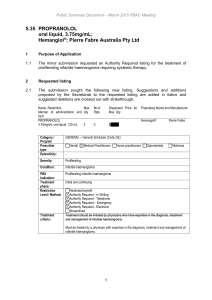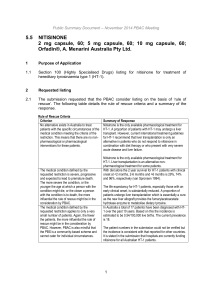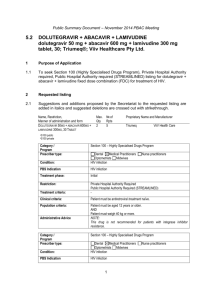Public Summary Document (PSD) July 2015 PBAC Meeting
advertisement
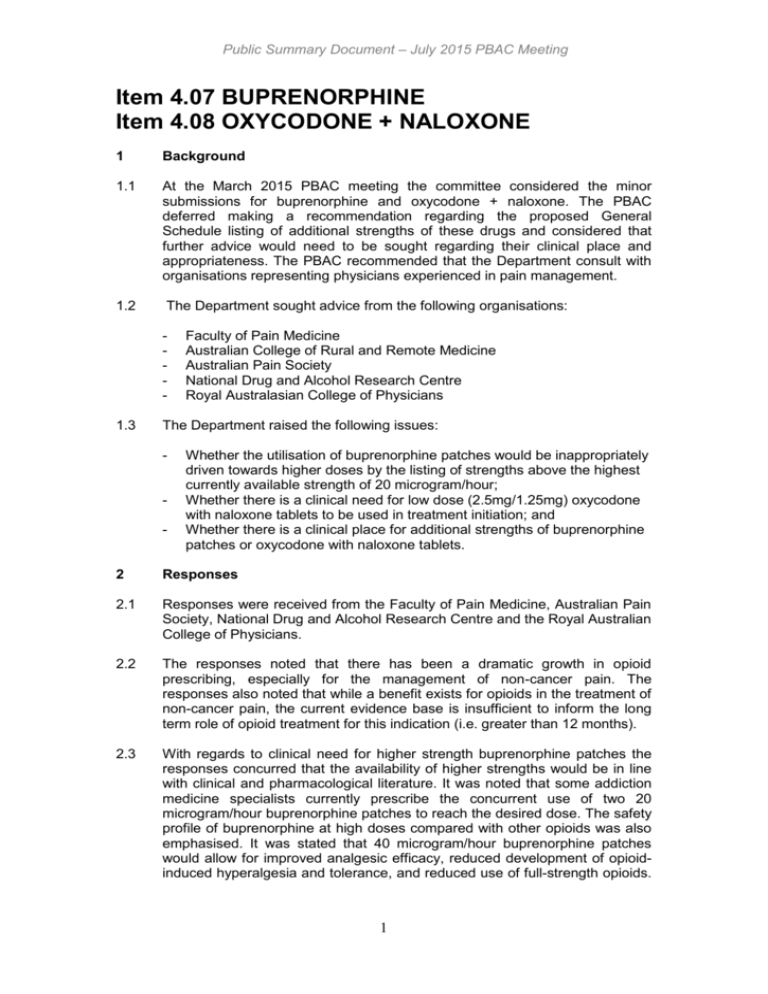
Public Summary Document – July 2015 PBAC Meeting Item 4.07 BUPRENORPHINE Item 4.08 OXYCODONE + NALOXONE 1 Background 1.1 At the March 2015 PBAC meeting the committee considered the minor submissions for buprenorphine and oxycodone + naloxone. The PBAC deferred making a recommendation regarding the proposed General Schedule listing of additional strengths of these drugs and considered that further advice would need to be sought regarding their clinical place and appropriateness. The PBAC recommended that the Department consult with organisations representing physicians experienced in pain management. 1.2 The Department sought advice from the following organisations: - 1.3 Faculty of Pain Medicine Australian College of Rural and Remote Medicine Australian Pain Society National Drug and Alcohol Research Centre Royal Australasian College of Physicians The Department raised the following issues: - - Whether the utilisation of buprenorphine patches would be inappropriately driven towards higher doses by the listing of strengths above the highest currently available strength of 20 microgram/hour; Whether there is a clinical need for low dose (2.5mg/1.25mg) oxycodone with naloxone tablets to be used in treatment initiation; and Whether there is a clinical place for additional strengths of buprenorphine patches or oxycodone with naloxone tablets. 2 Responses 2.1 Responses were received from the Faculty of Pain Medicine, Australian Pain Society, National Drug and Alcohol Research Centre and the Royal Australian College of Physicians. 2.2 The responses noted that there has been a dramatic growth in opioid prescribing, especially for the management of non-cancer pain. The responses also noted that while a benefit exists for opioids in the treatment of non-cancer pain, the current evidence base is insufficient to inform the long term role of opioid treatment for this indication (i.e. greater than 12 months). 2.3 With regards to clinical need for higher strength buprenorphine patches the responses concurred that the availability of higher strengths would be in line with clinical and pharmacological literature. It was noted that some addiction medicine specialists currently prescribe the concurrent use of two 20 microgram/hour buprenorphine patches to reach the desired dose. The safety profile of buprenorphine at high doses compared with other opioids was also emphasised. It was stated that 40 microgram/hour buprenorphine patches would allow for improved analgesic efficacy, reduced development of opioidinduced hyperalgesia and tolerance, and reduced use of full-strength opioids. 1 Public Summary Document – July 2015 PBAC Meeting It was also considered that less dose escalation would be expected compared with other opioids. 2.4 There were varying positions regarding the clinical need for additional strengths of oxycodone + naloxone, especially the lower 2.5 mg/1.25 mg strength. 2.5 The Australian College of Physicians (ACP) considered that there was an unclear clinical need for lower doses of oxycodone + naloxone, stating that combination products have limitations and their benefits are not well established. The ACP did state, however, that the higher dose combination may have some usefulness in palliative, oncological and/or pain medicine settings, given the limitations of the current maximum dose. 2.6 The Australian Pain Society (APS), on the other hand, considered that there was a clinical need for additional strengths of oxycodone + naloxone at both the low and higher doses. The APS argued that the varied oxycodone + naloxone strengths would provide for greater flexibility in up- and downtitration, with potential for lessened dose-related side effects. The APS highlighted that older patients with musculoskeletal pain who demonstrate sensitivity to opioid benefits and adverse effects (including skin intolerance to buprenorphine patches) would particularly benefit from the higher strengths of oxycodone + naloxone, especially in terms of analgesic compliance. 2.7 The National Drug and Alcohol Research Centre (NDARC) considered that there were some clinical situations, such as using lower doses and dose titrations in the elderly, where having a small dose option may be beneficial. 2.8 The responses were in general agreement that there was a clinical place for additional strengths of buprenorphine and oxycodone + naloxone. The issue of which additional strengths would be the most appropriate was not clear in the responses. 3 PBAC Outcome 3.1 The PBAC deferred making a recommendation regarding the proposed General Schedule listing of additional buprenorphine patch strengths. 3.2 The PBAC deferred making a recommendation regarding the proposed General Schedule listing of additional oxycodone + naloxone tablet strengths. 3.3 The PBAC noted the advice from the organisations representing physicians experienced in pain management. 3.4 The PBAC noted that while the responses were in general agreement that there was a clinical place for additional strengths of buprenorphine and oxycodone + naloxone, it was not clear which additional strengths would be the most appropriate. 3.5 The PBAC considered that it would not be appropriate to add further strengths of these opioids to the PBS without a consolidated view what combination of strengths of these drugs would be most appropriate for Australian clinical practice. 2 Public Summary Document – July 2015 PBAC Meeting 3.6 The PBAC requested that the Department undertake further consultation with relevant clinical and professional organisations regarding the clinical place of different opioid strengths. 4 Context for Decision The PBAC helps decide whether and, if so, how medicines should be subsidised in Australia. It considers submissions in this context. A PBAC decision not to recommend listing or not to recommend changing a listing does not represent a final PBAC view about the merits of the medicine. A company can resubmit to the PBAC or seek independent review of the PBAC decision. 5 Sponsor’s Comment The Sponsor notes that organisations consulted to date see a benefit in the listing of additional strengths for buprenorphine and oxycodone with naloxone. It will work with the PBAC to ensure that these additional strengths are made available for patients who would benefit from their availability. 3



